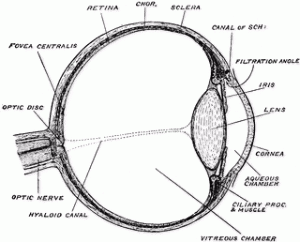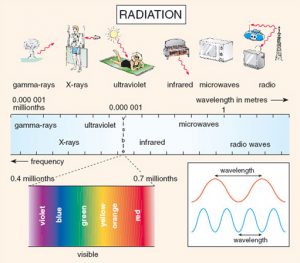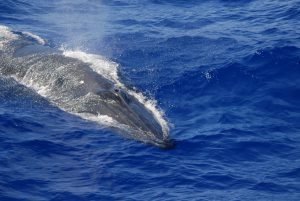We are visual creatures. Though humans have five senses, we can hear and smell pretty well, it is sight that REALLY tells us what is going on in the world around us. And for sight to work, light is needed. Light enters our eyes through an opening we call the pupil. It then makes contact with cells within our retina (rods and cones) that give us an image, depth of that image, and color. We have a lens that can bend the light waves to focus on a point on the retina where most of our receptor cells are – a spot called the fovea. As the object we are looking at moves towards, or away from us, our lens adjust (like that of a microscope) to keep the object on the fovea and within focus. We do have peripheral vision, light hitting portions of the retina other than the fovea, where we can see objects but not in as good a detail. These visual cues can mean life or death – and they only work with light.

Image: University of South Florida
Case in point… people say, “bats are blind”. Actually, they are not – they see quite well, but at night there is little or no light entering the eye. No light… no sight. So, the animal relies more on sound to perceive its world. The same can be said about sharks. Many say, “they have poor vision”. In reality, they have “poor light”. We can experience this as well. Let’s say you are standing on the beach near Ft. Pickens. It is beautiful day and you look north across Pensacola Bay to see NAS Pensacola – easy. Now imagine walking into Pensacola Bay. Deep enough where you are completely submerged – say 10 feet. Now look towards NAS Pensacola… what do you see?
Not much. The water may be clear enough that you could see 10 feet or so (maybe less). What you could see would be very close to you and have a blue-green hue to it. In the background you might see a group of rocks, or a metal can, that would be a light tan-green. Behind it, a dark blue field of… nothing. You could not see the fishing pier to your right and certainly not NAS straight in front of you. Do you all of a sudden have poor vision? No, just not enough light for your eyes to work properly – or for any great distance. Fish are like bats; they must rely on other senses to perceive their world well.
So, what is going on with light in water? Why can we not see as well?
It has to do with the nature of light and how it interacts with the water and the material within it.
Light is actually energy – coming towards you in little energy packets called photons that move in a wave motion. The distance between the crest of one wave (the top) and another is known as the wavelength. If the wavelength is relatively short – more crests will pass a given point in a given period of time. Meaning, if I am looking past a post in the water at waves coming by – if those wave crest were 10 feet apart from each other I would count fewer of them passing the post than I would if the distance between the crest were only one foot apart. This shorter wavelength is said to have a higher frequency – more waves per minute (or any other unit of time). Short waves with high frequency are said to have more energy than longer waves with lower frequency.
So it is with light. High frequency short waves of light would include things like gamma, alpha, and beta rays – as well as UV rays (ultraviolet). We know these waves have high energy, they can cause serious damage to our cells and can cause cancer. Many are in a group we call radiation, and X-rays would also be in this group. These short forms of light are so short we do not have cells that can detect them – we cannot see radiation of X-rays. Just a little bit shorter than ultraviolet light (UV light) is violet… and we can see that. Next would be blue, then green, yellow, orange, and the longest we can see is red. A bit longer than red is infrared – which we can only see using specialized night vision glasses. Longer than infrared, and out of our field of vision, would be radio and TV rays as well as radar. Even though we cannot seem all forms of light, it is all light and all energy.

Image: Open EDU
Our primary source of light is the sun. The sun is emitting a large amount of energy and much of that is detected as light. The waves of light coming from the sun is in all forms – high and low energy light. It travels across open space at a speed of 299,792,458 meters/second – this is 186,000 mi/sec or 669,600,000 mph… the speed of light. We think of space as “empty” but there are particles floating within and some of these particles will absorb or reflect this energy. As the material absorbs the light it absorbs the energy as well, the temperature of the material will increase (see Energy in the Ocean Lesson 1). Some of the light is reflected back into space, and some will move THROUGH the material changing speed and direction as it does – refraction.
When it reaches earth, it meets our atmosphere. Much of the atmosphere, particularly the ozone layer (O3) absorbs the light energy – heating the atmosphere as it does. What is nice, is much of the dangerous high energy light (shortwaves) is absorbed or reflected back into space – not all, but most. This is a plus for life on this planet, and a problem with trying to live on planets that do not have an atmosphere as such (take care of your atmosphere!). The light that penetrates the atmosphere will reach the surface of the planet… and us. There will be all sorts of wavelengths of light reaching us, including UV rays – which we need to protect ourselves from. We see all visible forms of light (all of the colors) at once – as the color white. It is very bright and can-do serious damage if we try to look at it directly – so don’t. Even non-direct sunlight can cause some problems – hence we wear sunglasses if we are going to be in it all day.

The colors of the world come from the reflection of the certain waves by materials within the object. For example, the pigment chlorophyll will be directly in the white light from the sun. All of the energy is absorbed by the chlorophyll except green – which is reflected back – and that is what we see… green. The energy from the rest of the light is used to fuel the process of photosynthesis. Your blue sweater is the same. Whatever pigment you dyed the sweater in absorbs all light except blue. So on and so on… our world.

Image: Minnesota Sea Grant
But water, and the materials within, is different than air. As the white light of the sun hits the surface of the ocean much of it is reflected back. The glare can be intense and most boaters wear sunglasses while at sea. Many will wear polarized sunglasses to greatly reduce the glare and allow them to see deeper into the water. The water, and materials within, tend to absorb, or reflect, the longer wavelengths first. In our range of vision this would be red. The color red is absorbed very quickly, hardly seen below the surface and basically gone at 30 feet. The next color to “disappear” would be orange (not seen at 30 feet), yellow (which can be seen to a depth of about 40-50 feet), then green (which can be seen to about 70 feet) and then blue… the deep ocean is all blue. This is the reason for the “ocean blue”. When you grab a glass of seawater, it is clear. When looking into the Gulf of Mexico you see blue. You are seeing the colors that have not been absorbed yet. At some point, about 200 feet in most locations, light becomes very dim. Below 3500 feet, there is no light at all, and we still have a long way to go to reach the bottom.
So, if red is gone before 30 feet, what color is a red snapper on the bottom of 80 feet of water?
The answer… blue.
If you cut yourself at this depth (don’t do this) but the blood would appear to your eye as blue. Now, if you shine a white flashlight on it – those colors will “reappear” but without artificial light, everything is blue. What is interesting is that some studies from the 1960s suggested that sharks might be more attracted to the colors red and yellow (longer wavelengths and a color you and I cannot see). I am not sure if those studies still stand up or, if they do, why? One test we did in college used one of the older xerox machines (I went to college a long time ago). You would write your name on a piece of paper using a marker of each primary color – red, yellow, green, blue, and violet. The copy made would have your name but in different shades of black to gray. The darkest one, was red. Weird. It may be that the eyes of marine animals might detect red as well, if not better, than other colors but would not see it as red. Very very interesting… I think.
Do the light waves absorb by the ocean near the surface warm the water as it does the atmosphere?
Yes… yes, it does. This goes back to our temperature talk (Lesson 1) and will help explain ocean currents (Lesson 3 coming next).
Sound…
We have heard about sound waves, but are they like light waves?
Yes… and no.

Image: University of Edinburugh.
They are waves, with wavelengths and frequency, but they are compression waves – not sine waves (as light would be). The other is the same as well. Shorter waves have a high frequency and more energy – just like light. More energy can cause more damage to your ears. Here we will introduce another measure of a wave – the amplitude. The amplitude is ½ the wave height. The wave height is the distance from wave crest (the top) to the wave trough (the bottom). The higher the amplitude, the greater the wave height, the more “intense” the sound – the louder it is and the more energy it has and damage it can do. We measure sound amplitude (sound loudness) using a logarithmic scale called a decibel. The scale is 10 so a sound that is 10 decibels higher than another is twice as loud. The more decibels a sound has, the more energy, the louder, etc.
Some examples:
Your breathing – 10 decibels (bB)
Inside a library – 40 dB
TV or a freeway 50 feet away – 70 dB
Lawn mower or motorcycle 25 feet away – 90 decibels
A jet aircraft taking off – 150 dB.
Damage to human ears begins at 80 dB. At those levels you would have to listen to it a long period of time for damage to occur. Anything over 110 dB can cause immediate damage.
Is sound different under water?
Yes…
The concept of sound traveling could be demonstrated in the classroom. Imagine you have 20 people standing in a straight line, all facing north. Each person is 10 feet apart. On a given signal the first person in line is asked to WALK up to the person in front of them and touch their shoulder. When that person feels the touch, they are to walk to the person in front to them and touch their shoulder. And on and on. Time how long it takes from the beginning of the process to the end.
Now, have a second line right next to them but the 20 people are only 1 foot apart. They can actually touch the person in front of them without walking. On a signal, both lines begin the process. Do you visualize that the line where the people are only 1 foot apart would finish sooner than those 10 feet apart?
Sound works in a similar fashion. Water is denser than air. At 15°C (density changes with temperature) air would have a density of 0.0000012 g/cm3. Water – would be 1.00 g/cm3. With the water molecules SO much closer than in air, the distance and speed of sound is greatly enhanced – and this is the density of FRESHWATER, adding salt increases the density even more. In air the speed of sound is 340 meters/second (761 mph). In water it is about 1480 meters/second (3311 mph!). So, sound travels faster and farther underwater than it does in air – and travels farther than light – many marine creatures utilize sound more than light.

Photo: NOAA
Can sound be produced at high enough decibels to cause damage to marine life?
Yes…
We now know that many deep sounding diesel engines, and underwater explosives, have caused problems for some marine creatures. Even marine creatures can produce sound with enough energy to stun their prey. Many species of toothed whales are known to produce intense sound waves to stun, or kill, their prey from a good distance. Most fish have cells along their sides (the lateral line) that can detect pressure waves (sound) from a great distance. It is believed that many species of sharks can detect sounds as far as way as 1000 meters (3400 feet – over ½ a mile). We also know, from the movie Finding Nemo, that tapping on the aquarium glass can create high intense sound waves that can cause damage to some fish – remember…. “find a happy place… FIND A HAPPY PLACE”.
So, we now understand that light and sound are both forces that move energy from one source to another. Some of the energy can be high enough to cause damage, some at levels that are quire useful to life. Next lesson we will explore more.
ACTIVITY
1) Try the xerox test (again, modern copiers may correct this for you). Write your name on a piece of paper using a red, orange, yellow, green, and blue marker. Use black also. Copy it. If the copy comes out in shades of black and gray – which is darker?
2) Many do not have a radio anymore, but if you do try this. You are listening to your favorite station (say 98.6). This number is the wave frequency being forwarded by the radio station. Increase the frequency, thus the energy and reduce the wavelength) to 101.1. What do you hear now?
3) Can you make a list of really loud sounds around your home? Which of these bother you?
4) Go outside at sunset today and look for bats. They will fly by without a sound. They are making a series of clicks to find the bugs, but we cannot hear them. You will notice the animals change and dart in different directions very quickly. This is in response to sounds that have caught their attention. They are amazing to watch.
5) If you have a swimming pool. Jump in with a metal pot and a spoon. Underwater bang on the pot and describe the noise that you hear. Lightly tapping a SCUBA tank with your dive knife is one-way divers signal other divers they cannot see so that they can meet up.
 0
0
